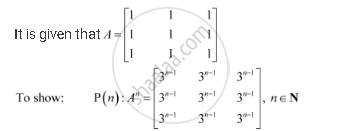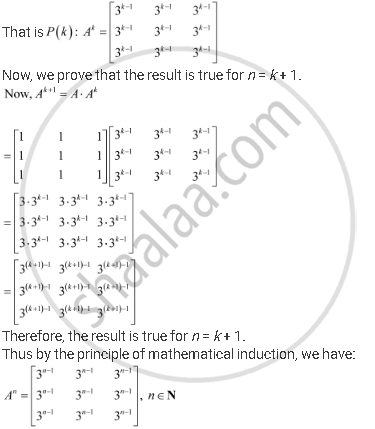Advertisements
Advertisements
प्रश्न
if A = [(1,1,1),(1,1,1),(1,1,1)], Prove that A" = `[(3^(n-1),3^(n-1),3^(n-1)),(3^(n-1),3^(n-1),3^(n-1)),(3^(n-1),3^(n-1),3^(n-1))]` `n in N`
उत्तर

We shall prove the result by using the principle of mathematical induction.
For n = 1, we have:

Therefore, the result is true for n = 1.
Let the result be true for n = k.

APPEARS IN
संबंधित प्रश्न
If A is a square matrix such that A2 = I, then find the simplified value of (A – I)3 + (A + I)3 – 7A.
If A is a square matrix, such that A2=A, then write the value of 7A−(I+A)3, where I is an identity matrix.
Find the value of x, y, and z from the following equation:
`[(4,3),(x,5)] = [(y,z),(1,5)]`
Find the value of a, b, c, and d from the equation:
`[(a-b, 2a+c),(2a-b, 3x+d)] = [(-1,5),(0,13)]`
Find the matrix X so that X`[(1,2,3),(4,5,6)]= [(-7,-8,-9),(2,4,6)]`
Given two matrices A and B
`A = [(1,-2,3),(1,4,1),(1,-3, 2)] and B = [(11,-5,-14),(-1, -1,2),(-7,1,6)]`
find AB and use this result to solve the following system of equations:
x - 2y + 3z = 6, x + 4x + z = 12, x - 3y + 2z = 1
If 𝒙 = r cos θ and y= r sin θ prove that JJ-1=1.
Investigate for what values of λ and μ the equations
2x + 3y + 5z = 9
7x + 3y - 2z = 8
2x + 3y + λz = μ have
A. No solutions
B. Unique solutions
C. An infinite number of solutions.
Classify the following matrix as, a row, a column, a square, a diagonal, a scalar, a unit, an upper triangular, a lower triangular, a symmetric or a skew-symmetric matrix:
`[(0, 4, 7),(-4, 0, -3),(-7, 3, 0)]`
Classify the following matrix as, a row, a column, a square, a diagonal, a scalar, a unit, an upper triangular, a lower triangular, a symmetric or a skew-symmetric matrix:
`[(2, 0, 0),(3, -1, 0),(-7, 3, 1)]`
Find k if the following matrix is singular:
`[(4, 3, 1),(7, "k", 1),(10, 9, 1)]`
If A = `[(7, 3, 1),(-2, -4, 1),(5, 9, 1)]`, Find (AT)T.
If A = `[(1, 2, 2),(2, 1, 2),(2, 2, 1)]`, Show that A2 – 4A is a scalar matrix
Answer the following question:
If A = diag [2 –3 –5], B = diag [4 –6 –3] and C = diag [–3 4 1] then find B + C – A
Answer the following question:
If A = `[(1, 2),(3, 2),(-1, 0)]` and B = `[(1, 3, 2),(4, -1, -3)]`, show that AB is singular.
Choose the correct alternative:
If B = `[(6, 3),(-2, "k")]` is singular matrix, then the value of k is ______
Choose the correct alternative:
If A = `[(2, 0),(0, 2)]`, then A2 – 3I = ______
If A = `[(2, 0, 0),(0, 1, 0),(0, 0, 1)]`, then |adj (A)| = ______
If A is a square matrix of order 2 such that A(adj A) = `[(7, 0),(0, 7)]`, then |A| = ______
If A = `[(1, 3, 3),(3, 1, 3),(3, 3, 1)]`, then show that A2 – 5A is a scalar matrix
If A and B are matrices of same order, then (3A –2B)′ is equal to______.
Given A = `[(2, 4, 0),(3, 9, 6)]` and B = `[(1, 4),(2, 8),(1, 3)]` is (AB)′ = B′A′?
If a matrix A is both symmetric and skew-symmetric, then ____________.
If `[(1,2),(3,4)],` then A2 - 5A is equal to ____________.
If A is a square matrix such that A2 = A, then (I + A)2 - 3A is ____________.
If a matrix A is both symmetric and skew symmetric then matrix A is ____________.
`[(5sqrt(7) + sqrt(7)) + (4sqrt(7) + 8sqrt(7))] - (19)^2` = ?
A matrix is said to be a column matrix if it has
A square matrix B = [bÿ] m × m is said to be a diagonal matrix if all diagonal elements are
If all the elements are zero, then matrix is said to be
A = `[a_(ij)]_(m xx n)` is a square matrix, if
The number of all possible matrices of order 3/3, with each entry 0 or 1 is
If the sides a, b, c of ΔABC satisfy the equation 4x3 – 24x2 + 47x – 30 = 0 and `|(a^2, (s - a)^2, (s - a)^2),((s - b)^2, b^2, (s - b)^2),((s - c)^2, (s - c)^2, c^2)| = p^2/q` where p and q are co-prime and s is semiperimeter of ΔABC, then the value of (p – q) is ______.
How many matrices can be obtained by using one or more numbers from four given numbers?
If A and B are square matrices of order 3 × 3 and |A| = –1, |B| = 3, then |3AB| equals ______.
If `[(1, 2, 1),(2, 3, 1),(3, a, 1)]` is non-singular matrix and a ∈ A, then the set A is ______.
Assertion: Let the matrices A = `((-3, 2),(-5, 4))` and B = `((4, -2),(5, -3))` be such that A100B = BA100
Reason: AB = BA implies AB = BA for all positive integers n.
